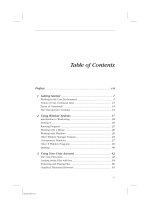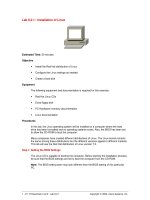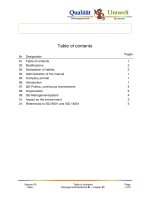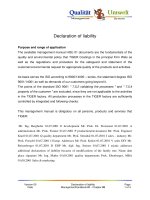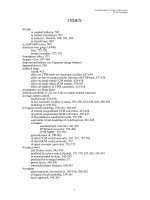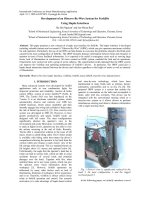Tài liệu Table of Contents pptx
Bạn đang xem bản rút gọn của tài liệu. Xem và tải ngay bản đầy đủ của tài liệu tại đây (154.13 KB, 12 trang )
Wang, Jun et al "Frontmatter"
Computational Intelligence in Manufacturing Handbook
Edited by Jun Wang et al
Boca Raton: CRC Press LLC,2001
©2001 CRC Press LLC
This book contains information obtained from authentic and highly regarded sources. Reprinted material is quoted with
permission, and sources are indicated. A wide variety of references are listed. Reasonable efforts have been made to publish
reliable data and information, but the author and the publisher cannot assume responsibility for the validity of all materials
or for the consequences of their use.
Neither this book nor any part may be reproduced or transmitted in any form or by any means, electronic or mechanical,
including photocopying, microfilming, and recording, or by any information storage or retrieval system, without prior
permission in writing from the publisher.
All rights reserved. Authorization to photocopy items for internal or personal use, or the personal or internal use of specific
clients, may be granted by CRC Press LLC, provided that $.50 per page photocopied is paid directly to Copyright Clearance
Center, 222 Rosewood Drive, Danvers, MA 01923 USA. The fee code for users of the Transactional Reporting Service is
ISBN 0-8493-0592-6/01/$0.00+$.50. The fee is subject to change without notice. For organizations that have been granted
a photocopy license by the CCC, a separate system of payment has been arranged.
The consent of CRC Press LLC does not extend to copying for general distribution, for promotion, for creating new works,
or for resale. Specific permission must be obtained in writing from CRC Press LLC for such copying.
Direct all inquiries to CRC Press LLC, 2000 N.W. Corporate Blvd., Boca Raton, Florida 33431.
Trademark Notice:
Product or corporate names may be trademarks or registered trademarks, and are used only for
identification and explanation, without intent to infringe.
© 2001 by CRC Press LLC
No claim to original U.S. Government works
International Standard Book Number 0-8493-0592-6
Library of Congress Card Number 00-049826
Printed in the United States of America 1 2 3 4 5 6 7 8 9 0
Printed on acid-free paper
Library of Congress Cataloging-in-Publication Data
Wang, Jun.
Computational intelligence in manufacturing handbook / Jun Wang and Andrew Kusiak.
p. cm. — (Mechanical engineering)
Includes bibliographical references and index.
ISBN 0-8493-0592-6 (alk. paper)
1. Production management—Data processing. 2. Computational intelligence—Industrial
applications. 3. Manufacturing processes—Automation. I. Title. II. Advanced topics in
mechanical engineering series
TS155.6 .W36 2000
658.5'14—dc21 00-049826
CIP
©2001 CRC Press LLC
Preface
Computational intelligence involves science-based approaches and technologies for analyzing, designing,
and developing intelligent systems. The broad usage of this term was formalized by the IEEE Neural
Network Council and the IEEE World Congress on Computational Intelligence in Orlando, Florida in
the summer of 1994. It represents a union of neural networks, fuzzy systems, evolutionary computation
techniques, and other emerging intelligent agents and technologies.
The past two decades have witnessed the resurgence of studies in neural networks, fuzzy logic, and
genetic algorithms in the areas we now call computational intelligence. Advances in theory and meth-
odology have overcome many obstacles that previously hindered the computational intelligence research.
The research has sparked considerable interest among scientists and engineers from many disciplines. As
evidenced by the appealing results of numerous studies, computational intelligence has gained acceptance
and popularity. In addition, computational intelligence techniques have been applied to solve numerous
problems in a variety of application settings. The computational intelligence research opened many new
dimensions for scientific discovery and industrial/business applications. The desirable features of com-
putationally intelligent systems and their initial successes in applications have inspired renewed interest
in practitioners from industry and service organizations. The truly interdisciplinary environment of the
research and development offers rewarding opportunities for scientific breakthrough and technology
innovation.
The applications of computational intelligence in manufacturing, in particular, play a leading role in
the technology development of intelligent manufacturing systems. The manufacturing applications of
computational intelligence span a wide spectrum including manufacturing system design, manufacturing
process planning, manufacturing process monitoring control, product quality control, and equipment
fault diagnosis. In the past decade, numerous publications have been devoted to manufacturing appli-
cations of neural networks, fuzzy logic, and evolutionary computation. Despite the large volume of
publications, there are few comprehensive books addressing the applications of computational intelligence
in manufacturing. In an effort to fill the void, this comprehensive handbook was produced to cover
various topics on the manufacturing applications of computational intelligence. The aim of this handbook
is to present the state of the art and highlight the recent advances on the computational intelligence
applications in manufacturing. As a handbook, it contains a balanced coverage of tutorials and new
results.
This handbook is intended for a wide readership ranging from professors and students in academia
to practitioners and researchers in industry and business, including engineers, project managers, and
R&D staff, who are affiliated with a number of major professional societies such as IEEE, ASME, SME,
IIE, and their counterparts in Europe, Asia, and the rest of the world. The book is a source of new
information for understanding technical details, assessing research potential, and defining future direc-
tions in the applications of computational intelligence in manufacturing.
©2001 CRC Press LLC
This handbook consists of 19 chapters organized in five parts in terms of levels and areas of applications.
The contributed chapters are authored by more than 30 leading experts in the fields from top institutions
in Asia, Europe, North America, and Oceania.
Part I contains two chapters that present an overview of the applications of computational intelligence
in manufacturing. Specifically, Chapter 1 by D. T. Pham and P. T. N. Pham offers a tutorial on compu-
tational intelligence in manufacturing to lead the reader into a broad spectrum of intelligent manufac-
turing applications. Chapter 2 by Wang, Tang, and Roze gives an updated survey of neural network
applications in intelligent manufacturing to keep the reader informed of history and new development
in the subject of study.
Part II of the handbook presents five chapters that address the issues in computational intelligence for
modeling and design of manufacturing systems. In this category, Chapter 3 by Ulieru, Stefanoiu, and
Norrie presents a metamorphic framework based on fuzzy logic for intelligent manufacturing. Chapter
4 by Suresh discusses the neural network applications in group technology and cellular manufacturing,
which has been one of the popular topics investigated by many researchers. Chapter 5 by Kazerooni et
al. discusses an application of fuzzy logic to design flexible manufacturing systems. Chapter 6 by Luong
et al. discusses the use of genetic algorithms in group technology. Chapter 7 by Chang and Tsai discusses
intelligent design retrieving systems using neural networks.
Part III contains three chapters and focuses on manufacturing process planning and scheduling using
computational intelligence techniques. Chapter 8 by Lee, Chiu, and Fang addresses the issues on optimal
process planning and sequencing of parallel machining. Chapter 9 by Zhang and Nee presents the appli-
cations of genetic algorithms and simulated annealing algorithm for process planning. Chapter 10 by
Cheng and Gen presents the applications of genetic algorithms for production planning and scheduling.
Part IV of the book is composed of five chapters and is concerned with monitoring and control of
manufacturing processes based on neural and fuzzy systems. Specifically, Chapter 11 by Lam and Smith
presents predictive process models based on cascade neural networks with three diverse manufacturing
applications. In Chapter 12, Cho discusses issues on monitoring and control of manufacturing process
using neural networks. In Chapter 13, May gives a full-length discussion on computational intelligence
applications in microelectronic manufacturing. In Chapter 14, Du and Xu present fuzzy logic approaches
to manufacturing process monitoring and diagnosis. In Chapter 15, Li discusses the uses of fuzzy neural
networks and wavelet techniques for on-line monitoring cutting tool conditions.
Part V has four chapters that address the issues on quality assurance of manufactured products and
fault diagnosis of manufacturing facilities. Chapter 16 by Chen discusses an in-process surface roughness
recognition system based on neural network and fuzzy logic for end milling operations. Chapter 17 by
Chinnam presents intelligent quality controllers for on-line selection of parameters of manufacturing
systems. Chapter 18 by Chang discusses a hybrid neural fuzzy system for statistical process control. Finally,
Chapter 19 by Khoo and Zhai discusses a diagnosis approach based on rough set and genetic algorithms.
We would like to express our gratitude to all the contributors of this handbook for their efforts in
preparing their chapters. In addition, we wish to thank the professionals at CRC Press LLC, which has
a tradition of publishing well-known handbooks, for their encouragement and trust. Finally, we would
like to thank Cindy R. Carelli, the CRC Press acquiring editor who coordinated the publication of this
handbook, for her assistance and patience throughout this project.
Jun Wang Andrew Kusiak
Hong Kong Iowa City
©2001 CRC Press LLC
Editors
Jun Wang
is an Associate Professor and the Director of Computational Intelligence Lab in the Department
of Automation and Computer-Aided Engineering at the Chinese University of Hong Kong. Prior to this
position, he was an Associate Professor at the University of North Dakota, Grand Forks. He received his
B.S. degree in electrical engineering and his M.S. degree in systems engineering from Dalian University
of Technology, China and his Ph.D. degree in systems engineering from Case Western Reserve University,
Cleveland, Ohio. Dr. Wang’s current research interests include neural networks and their engineering
applications. He has published more than 60 journal papers, 10 book chapters, 2 edited books, and
numerous papers in conference proceedings. He serves as an Associate Editor of the
IEEE Transactions
on Neural Networks.
Andrew Kusiak
is a Professor of Industrial Engineering at the University of Iowa, Iowa City. His interests
include applications of computational intelligence in product development, manufacturing, and health-
care informatics and technology. He has published research papers in journals sponsored by AAAI, ASME,
IEEE, IIE, INFORMS, ESOR, IFIP, IFAC, IPE, ISPE, and SME. Dr. Kusiak speaks frequently at interna-
tional meetings, conducts professional seminars, and consults for industrial corporations. He has served
on the editorial boards of 16 journals, has written 15 books and edited various book series, and is the
Editor-in-Chief of the
Journal of Intelligent Manufacturing
.
©2001 CRC Press LLC
Contributors
K. Abhary
University of South Australia
Australia
F. T. S. Chan
University of Hong Kong
China
C. Alec Chang
University of Missouri–Columbia
U.S.A.
Shing I. Chang
Kansas State University
U.S.A.
Joseph C. Chen
Iowa State University
U.S.A.
Runwei Cheng
Ashikaga Institute of Technology
Japan
Ratna Babu Chinnam
Wayne State University
U.S.A
Nan-Chieh Chiu
North Carolina State University
U.S.A.
Hyung Suck Cho
Korea Advanced Institute
of Science and Technology
South Korea
R. Du
University of Miami
U.S.A.
Shu-Cherng Fang
North Carolina State University
U.S.A.
Mitsuo Gen
Ashikaga Institute of Technology
Japan
A. Kazerooni
University of Lavisan
Iran
M. Kazerooni
Toosi University of Technology
Iran
Li-Pheng Khoo
Nanyang Technological University
Singapore
Sarah S. Y. Lam
State University of New York
at Binghamton
U.S.A.
Yuan-Shin Lee
North Carolina State University
U.S.A.
Xiaoli Li
Harbin Institute of Technology
China
L. H. S. Luong
University of South Australia
Australia
Gary S. May
Georgia Institute of Technology
U.S.A.
A. Y. C. Nee
National University of Singapore
Singapore
Douglas Norrie
University of Calgary
Canada
D. T. Pham
University of Wales
Cardiff, U.K.
P. T. N. Pham
University of Wales
Cardiff, U.K.
Catherine Roze
IBM Global Services
U.S.A.
Alice E. Smith
Auburn University
U.S.A.
Dan Stefanoiu
University of Calgary
Canada
Nallan C. Suresh
State University of New York
at Buffalo
U.S.A.
University of Groningen
The Netherlands
Wai Sum Tang
The Chinese University
of Hong Kong
China
Chieh-Yuan Tsai
Yuan-Ze University
Taiwan
Michaela Ulieru
University of Calgary
Canada
Jun Wang
The Chinese University
of Hong Kong
China
©2001 CRC Press LLC
Yangsheng Xu
The Chinese University
of Hong Kong
China
Lian-Yin Zhai
Nanyang Technological University
Singapore
Y. F. Zhang
National University of Singapore
Singapore
©2001 CRC Press LLC
Table of Contents
PART I Overview
1
Computational Intelligence for Manufacturing
D. T. Pham
·
P. T. N. Pham
1.1 Introduction
1.2 Knowledge-Based Systems
1.3 Fuzzy Logic
1.4 Inductive Learning
1.5 Neural Networks
1.6 Genetic Algorithms
1.7 Some Applications in Engineering and Manufacture
1.8 Conclusion
2
Neural Network Applications in Intelligent Manufacturing:
An Updated Survey
Jun Wang · Wai Sum Tang · Catherine Roze
2.1 Introduction
2.2 Modeling and Design of Manufacturing Systems
2.3 Modeling, Planning, and Scheduling of Manufacturing Processes
2.4 Monitoring and Control of Manufacturing Processes
2.5 Quality Control, Quality Assurance, and Fault Diagnosis
2.6 Concluding Remarks
3
Holonic Metamorphic Architectures for Manufacturing: Identifying
Holonic Structures in Multiagent Systems by Fuzzy Modeling
Michaela Ulieru · Dan Stefanoiu · Douglas Norrie
3.1 Introduction
3.2 Agent-Oriented Manufacturing Systems
3.3 The MetaMorph Project
3.4 Holonic Manufacturing Systems
3.5 Holonic Self-Organization of MetaMorph via Dynamic Virtual Clustering
3.6 Automatic Grouping of Agents into Holonic System: Simulation Results
3.7 MAS Self-Organization as a Holonic System: Simulation Results
3.8 Conclusions
©2001 CRC Press LLC
PART II Manufacturing System Modeling and Design
4
Neural Network Applications for Group Technology and Cellular
Manufacturing
Nallan C. Suresh
4.1 Introduction
4.2 Artificial Neural Networks
4.3 A Taxonomy of Neural Network Application for GT/CM
4.4 Conclusions
5
Application of Fuzzy Set Theory in Flexible Manufacturing
System Design
A. Kazerooni · K. Abhary · L. H. S. Luong · F. T. S. Chan
5.1 Introduction
5.2 A Multi-Criterion Decision-Making Approach for Evaluation of Scheduling Rules
5.3 Justification of Representing Objectives with Fuzzy Sets
5.4 Decision Points and Associated Rules
5.5 A Hierarchical Structure for Evaluation of Scheduling Rules
5.6 A Fuzzy Approach to Operation Selection
5.7 Fuzzy-Based Part Dispatching Rules in FMSs
5.8 Fuzzy Expert System-Based Rules
5.9 Selection of Routing and Part Dispatching Using Membership Functions and
Fuzzy Expert System-Based Rules
6
Genetic Algorithms in Manufacturing System Design
L. H. S. Luong · M. Kazerooni · K. Abhary
6.1 Introduction
6.2 The Design of Cellular Manufacturing Systems
6.3 The Concepts of Similarity Coefficients
6.4 A Genetic Algorithm for Finding the Optimum Process Routings for Parts
6.5 A Genetic Algorithm to Cluster Machines into Machine Groups
6.6 A Genetic Algorithm to Cluster Parts into Part Families
6.7 Layout Design
6.8 A Genetic Algorithm for Layout Optimization
6.9 A Case Study
6.10 Conclusion
7
Intelligent Design Retrieving Systems Using Neural Networks
C. Alec Chang · Chieh-Yuan Tsai
7.1 Introduction
7.2 Characteristics of Intelligent Design Retrieval
7.3 Structure of an Intelligent System
7.4 Performing Fuzzy Association
7.5 Implementation Example
©2001 CRC Press LLC
PART III Process Planning and Scheduling
8
Soft Computing for Optimal Planning and Sequencing of
Parallel Machining Operations
Yuan-Shin Lee · Nan-Chieh Chiu · Shu-Cherng Fang
8.1 Introduction
8.2 A Mixed Integer Program
8.3 A Genetic-Based Algorithm
8.4 Tabu Search for Sequencing Parallel Machining Operations
8.5 Two Reported Examples Solved by the Proposed GA
8.6 Two Reported Examples Solved by the Proposed Tabu Search
8.7 Random Problem Generator and Further Tests
8.8 Conclusion
9
Application of Genetic Algorithms and Simulated Annealing
in Process Planning Optimization
Y. F. Zhang · A. Y. C. Nee
9.1 Introduction
9.2 Modeling Process Planning Problems in an Optimization Perspective
9.3 Applying a Genetic Algorithm to the Process Planning Problem
9.4 Applying Simulated Annealing to the Process Planning Problem
9.5 Comparison between the GA and the SA Algorithm
9.6 Conclusions
10
Production Planning and Scheduling Using Genetic Algorithms
Runwei Cheng · Mitsuo Gen
10.1 Introduction
10.2 Resource-Constrained Project Scheduling Problem
10.3 Parallel Machine Scheduling Problem
10.4 Job-Shop Scheduling Problem
10.5 Multistage Process Planning
10.6 Part Loading Scheduling Problem
PART IV Manufacturing Process Monitoring and Control
11
Neural Network Predictive Process Models:
Three Diverse Manufacturing Applications
Sarah S. Y. Lam · Alice E. Smith
11.1 Introduction to Neural Network Predictive Process Models
11.2 Ceramic Slip Casting Application
11.3 Abrasive Flow Machining Application
11.4 Chemical Oxidation Application
11.5 Concluding Remarks
©2001 CRC Press LLC
12
Neural Network Applications to Manufacturing Processes:
Monitoring and Control
Hyung Suck Cho
12.1 Introduction
12.2 Manufacturing Process Monitoring and Control
12.3 Neural Network-Based Monitoring
12.4 Quality Monitoring Applications
12.5 Neural Network-Based Control
12.6 Process Control Applications
12.7 Conclusions
13 Computational Intelligence in Microelectronics Manufacturing
Gary S. May
13.1 Introduction
13.2 The Role of Computational Intelligence
13.3 Process Modeling
13.4 Optimization
13.5 Process Monitoring and Control
13.6 Process Diagnosis
13.7 Summary
14 Monitoring and Diagnosing Manufacturing Processes
Using Fuzzy Set Theory
R. Du · Yangsheng Xu
14.1 Introduction
14.2 A Brief Description of Fuzzy Set Theory
14.3 Monitoring and Diagnosing Manufacturing Processes Using Fuzzy Sets
14.4 Application Examples
14.5 Conclusions
15 Fuzzy Neural Network and Wavelet for Tool Condition Monitoring
Xiaoli Li
15.1 Introduction
15.2 Fuzzy Neural Network
15.3 Wavelet Transforms
15.4 Tool Breakage Monitoring with Wavelet Transforms
15.5 Identification of Tool Wear States Using Fuzzy Method
15.6 Tool Wear Monitoring with Wavelet Transforms and Fuzzy Neural Network
©2001 CRC Press LLC
PART V Quality Assurance and Fault Diagnosis
16 Neural Networks and Neural-Fuzzy Approaches in an In-Process
Surface Roughness Recognition System for End Milling Operations
Joseph C. Chen
16.1 Introduction
16.2 Methodologies
16.3 Experimental Setup and Design
16.4 The In-Process Surface Roughness Recognition Systems
16.5 Testing Results and Conclusion
17 Intelligent Quality Controllers for On-Line Parameter Design
Ratna Babu Chinnam
17.1 Introduction
17.2 An Overview of Certain Emerging Technologies Relevant to On-Line
Parameter Design
17.3 Design of Quality Controllers for On-Line Parameter Design
17.4 Case Study: Plasma Etching Process Modeling and On-Line Parameter Design
17.5 Conclusion
18 A Hybrid Neural Fuzzy System for Statistical Process Control
Shing I Chang
18.1 Statistical Process Control
18.2 Neural Network Control Charts
18.3 A Hybrid Neural Fuzzy Control Chart
18.4 Design, Operations, and Guidelines for Using the Proposed Hybrid Neural Fuzzy
Control Chart
18.5 Properties of the Proposed Hybrid Neural Fuzzy Control Chart
18.6 Final Remarks
19 RClass*: A Prototype Rough-Set and Genetic Algorithms Enhanced
Multi-Concept Classification System for Manufacturing Diagnosis
Li-Pheng Khoo · Lian-Yin Zhai
19.1 Introduction
19.2 Basic Notions
19.3 A Prototype Multi-Concept Classification System
19.4 Validation of RClass*
19.5 Application of RClass* to Manufacturing Diagnosis
19.6 Conclusions
